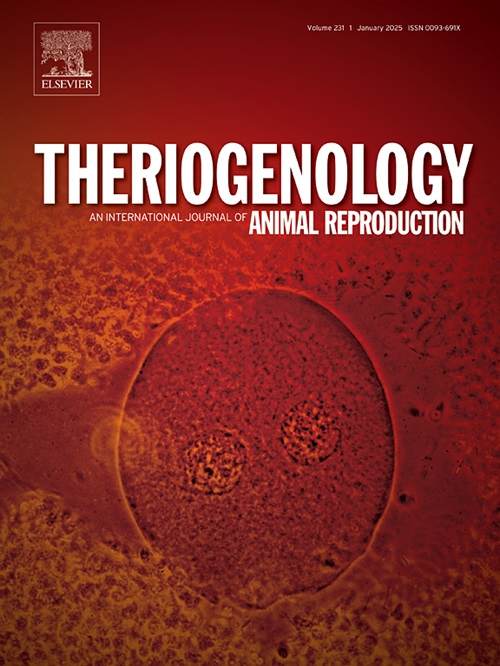肉牛活动监测装置数据与卵巢、子宫、激素和妊娠变量之间的关系。
IF 2.4
2区 农林科学
Q3 REPRODUCTIVE BIOLOGY
引用次数: 0
摘要
在牛肉操作中实施加速度计技术是提高发情检测精度的另一种选择。我们假设:(1)加速度计算法在检测放牧肉牛的行为发情方面与视觉观察压力敏感传感器(发情斑块)具有相似的准确性;(2)加速度计测量的变量,如发情强度,与发情之前、期间和之后监测的激素、卵巢和子宫变量相关;(3)加速度计变量与胚胎移植(ET)放牧肉牛的怀孕概率相关。在随后的8轮同步协议后,50头奶牛安装了加速计和补丁来检测发情。每轮,只有发情的奶牛(第0天;分别于发情前期、发情期和早衰期测定卵泡直径、子宫内膜厚度、黄体面积、雌二醇(E2)和黄体酮(P4)浓度。D7行ET。在第46天诊断出怀孕,奶牛在35天恢复,然后进行新的复制。与加速度计算法相比,补丁在检测行为发情方面具有更高的准确性(98%对91%)。加速度计显示,发情强度较低的奶牛在D0时卵泡直径增大(P = 0.022), D4和D7时CL面积增大(P = 0.05), D-1时子宫内膜厚度增大(P = 0.10), D-1时E2浓度降低(P = 0.0032)。加速度计变量不能准确预测怀孕/ET的概率。综上所述,视觉观察斑块比加速度计算法更准确地检测发情,加速度计与生理变量之间的关联大部分是在发情前测量的特征。本文章由计算机程序翻译,如有差异,请以英文原文为准。
Relationships between activity monitoring device data and ovarian, uterine, hormonal, and pregnancy variables in beef cows
Implementing accelerometer technologies in beef operations is an alternative to increase precision in estrous detection. We hypothesized that (1) the accelerometer algorithm has similar accuracy in detecting behavioral estrus as does visual observation of pressure-sensitive sensors (estrus patches) in grazing beef cows; (2) variables measured by the accelerometer, such as estrus intensity, are associated with hormonal, ovarian, and uterine variables monitored before, during, and after estrus; and (3) the accelerometer variables are associated with the probability of pregnancy in grazing beef cows submitted to embryo transfer (ET). Fifty cows were fitted with accelerometer and patches to detect estrus after a synchronization protocol in eight subsequent rounds. For each round, only cows that showed estrus (day 0; D0) received ET. Follicular diameter, endometrial thickness, corpus luteum (CL) area, and estradiol (E2) and progesterone (P4) concentrations were measured during proestrus, estrus, and early diestrus. On D7, ET was performed. Pregnancies were diagnosed on D46 and cows recovered for 35D before a new replicate. Patches had a greater accuracy (98 % vs. 91 %) of detection of behavioral estrus than accelerometer algorithm. Cows with lower estrus intensity in the accelerometer had greater follicular diameter on D0 (P = 0.022), CL area on D4 and D7 (P = 0.05), endometrial thickness on D-1 (P = 0.10), and reduced E2 concentrations on D-1 (P = 0.0032). The accelerometer variables did not predict accurately the probability of pregnancy/ET. In conclusion, visual observation of patches was more accurate in detecting estrus than the accelerometer algorithm and most of the associations between accelerometers and physiological variables were for characteristics measured at proestrus.
求助全文
通过发布文献求助,成功后即可免费获取论文全文。
去求助
来源期刊

Theriogenology
农林科学-生殖生物学
CiteScore
5.50
自引率
14.30%
发文量
387
审稿时长
72 days
期刊介绍:
Theriogenology provides an international forum for researchers, clinicians, and industry professionals in animal reproductive biology. This acclaimed journal publishes articles on a wide range of topics in reproductive and developmental biology, of domestic mammal, avian, and aquatic species as well as wild species which are the object of veterinary care in research or conservation programs.
 求助内容:
求助内容: 应助结果提醒方式:
应助结果提醒方式:


